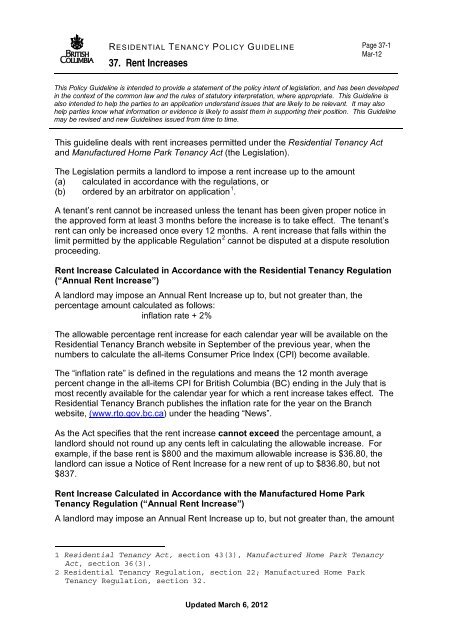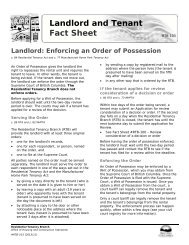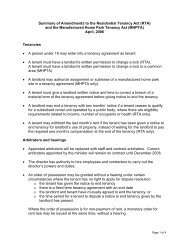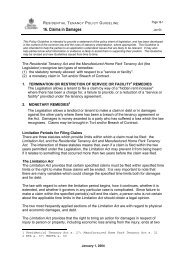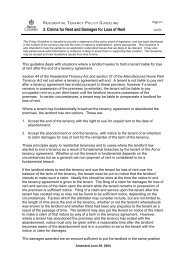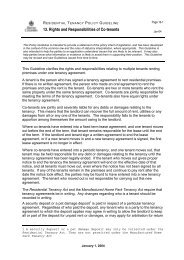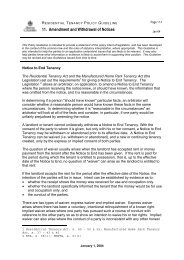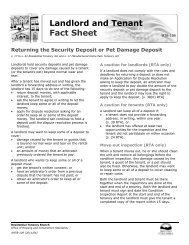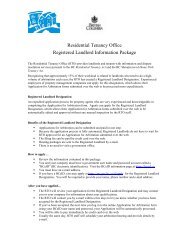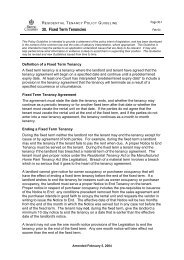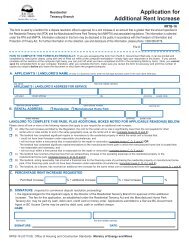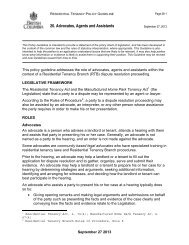37. Rent Increases - Residential Tenancy Office
37. Rent Increases - Residential Tenancy Office
37. Rent Increases - Residential Tenancy Office
You also want an ePaper? Increase the reach of your titles
YUMPU automatically turns print PDFs into web optimized ePapers that Google loves.
RESIDENTIAL TENANCY POLICY GUIDELINE<br />
<strong>37.</strong> <strong>Rent</strong> <strong>Increases</strong><br />
Page 37-1<br />
Mar-12<br />
This Policy Guideline is intended to provide a statement of the policy intent of legislation, and has been developed<br />
in the context of the common law and the rules of statutory interpretation, where appropriate. This Guideline is<br />
also intended to help the parties to an application understand issues that are likely to be relevant. It may also<br />
help parties know what information or evidence is likely to assist them in supporting their position. This Guideline<br />
may be revised and new Guidelines issued from time to time.<br />
This guideline deals with rent increases permitted under the <strong>Residential</strong> <strong>Tenancy</strong> Act<br />
and Manufactured Home Park <strong>Tenancy</strong> Act (the Legislation).<br />
The Legislation permits a landlord to impose a rent increase up to the amount<br />
(a) calculated in accordance with the regulations, or<br />
(b) ordered by an arbitrator on application 1 .<br />
A tenant’s rent cannot be increased unless the tenant has been given proper notice in<br />
the approved form at least 3 months before the increase is to take effect. The tenant’s<br />
rent can only be increased once every 12 months. A rent increase that falls within the<br />
limit permitted by the applicable Regulation 2 cannot be disputed at a dispute resolution<br />
proceeding.<br />
<strong>Rent</strong> Increase Calculated in Accordance with the <strong>Residential</strong> <strong>Tenancy</strong> Regulation<br />
(“Annual <strong>Rent</strong> Increase”)<br />
A landlord may impose an Annual <strong>Rent</strong> Increase up to, but not greater than, the<br />
percentage amount calculated as follows:<br />
inflation rate + 2%<br />
The allowable percentage rent increase for each calendar year will be available on the<br />
<strong>Residential</strong> <strong>Tenancy</strong> Branch website in September of the previous year, when the<br />
numbers to calculate the all-items Consumer Price Index (CPI) become available.<br />
The “inflation rate” is defined in the regulations and means the 12 month average<br />
percent change in the all-items CPI for British Columbia (BC) ending in the July that is<br />
most recently available for the calendar year for which a rent increase takes effect. The<br />
<strong>Residential</strong> <strong>Tenancy</strong> Branch publishes the inflation rate for the year on the Branch<br />
website, (www.rto.gov.bc.ca) under the heading “News”.<br />
As the Act specifies that the rent increase cannot exceed the percentage amount, a<br />
landlord should not round up any cents left in calculating the allowable increase. For<br />
example, if the base rent is $800 and the maximum allowable increase is $36.80, the<br />
landlord can issue a Notice of <strong>Rent</strong> Increase for a new rent of up to $836.80, but not<br />
$8<strong>37.</strong><br />
<strong>Rent</strong> Increase Calculated in Accordance with the Manufactured Home Park<br />
<strong>Tenancy</strong> Regulation (“Annual <strong>Rent</strong> Increase”)<br />
A landlord may impose an Annual <strong>Rent</strong> Increase up to, but not greater than, the amount<br />
1 <strong>Residential</strong> <strong>Tenancy</strong> Act, section 43(3), Manufactured Home Park <strong>Tenancy</strong><br />
Act, section 36(3).<br />
2 <strong>Residential</strong> <strong>Tenancy</strong> Regulation, section 22; Manufactured Home Park<br />
<strong>Tenancy</strong> Regulation, section 32.<br />
Updated March 6, 2012
RESIDENTIAL TENANCY POLICY GUIDELINE<br />
<strong>37.</strong> <strong>Rent</strong> <strong>Increases</strong><br />
Page 37-2<br />
Mar-12<br />
calculated as follows:<br />
inflation rate + 2% + proportional amount 3<br />
The allowable percentage rent increase (inflation rate + 2%) for each calendar year will<br />
be available on the <strong>Residential</strong> <strong>Tenancy</strong> Branch website in September of the previous<br />
year, when the numbers to calculate the all-items Consumer Price Index (CPI) become<br />
available.<br />
The “inflation rate” is defined in the regulations and means the 12-month average<br />
percent change in the all-items CPI for British Columbia (BC) ending in the July that is<br />
most recently available for the calendar year for which a rent increase takes effect. The<br />
<strong>Residential</strong> <strong>Tenancy</strong> Branch publishes the inflation rate for the year on the Branch<br />
website, (www.rto.gov.bc.ca) under the heading “News”.<br />
The “proportional amount” is the sum of the change in local government levies and the<br />
change in utility fees divided by the number of manufactured home sites in the<br />
manufactured home park.<br />
The “change in local government levies” is the local government levies for the 12-month<br />
period ending at the end of the month before the month in which notice under section<br />
35(2) of the Act was given, less the local government levies for the previous 12-month<br />
period. The formula for the change in local government levies is:<br />
this year’s levies – last year’s levies<br />
The “change in utility fees” is the utility fees for the 12-month period ending at the end of<br />
the month before the month in which notice under section 35(2) of the Act was given,<br />
less the utility fees for the previous 12-month period. The formula for the change in utility<br />
fees is:<br />
this year’s fees – last year’s fees<br />
The term “local government levies” means the sum of the payments respecting a<br />
manufactured home park made by the landlord for property tax values, and municipal<br />
fees under section 194 of the Community Charter.<br />
The term “utility fees” means the sum of the payments respecting a manufactured home<br />
park made by the landlord for the supply of electricity, natural gas, water, telephone<br />
services or coaxial cable services provided by the following:<br />
a) a public utility as defined in section 1 of the Utilities Commission Act;<br />
b) a gas utility as defined in section 1 of the Gas Utility Act;<br />
c) a water utility as defined in section 1 of the Water Utility Act;<br />
d) a corporation licensed by the Canadian Radio-television and<br />
Telecommunications Commission for the purposes of that supply.<br />
Expenses that do not meet the definition of “local government fees” and “utility fees”<br />
cannot be included when calculating a rent increase. If electricity is generated by diesel<br />
fuel, for example, a landlord may not include the increased cost of diesel fuel. The fees<br />
must be paid to a local government or a regulation utility in order to be included.<br />
3 Effective July 18, 2007.<br />
Updated March 6, 2012
RESIDENTIAL TENANCY POLICY GUIDELINE<br />
<strong>37.</strong> <strong>Rent</strong> <strong>Increases</strong><br />
Page 37-3<br />
Mar-12<br />
As the Act specifies that the rent increase cannot exceed the calculated amount, a<br />
landlord should not round up any cents left in calculating the allowable increase. For<br />
example, if the base rent is $800 and the maximum allowable increase is $36.80, the<br />
landlord can issue a Notice of <strong>Rent</strong> Increase for a new rent of up to $836.80, but not<br />
$8<strong>37.</strong><br />
Tenant May Agree to a <strong>Rent</strong> Increase Greater than the Prescribed Amount<br />
A landlord who desires to increase a tenant’s rent by more than the amount of the<br />
allowed annual rent increase can ask the tenant to agree to an increase that is greater<br />
than that allowed amount. If the tenant agrees in writing to the proposed increase, the<br />
landlord is not required to apply to an arbitrator for approval of that rent increase. The<br />
landlord must still follow requirements regarding the timing and notice of rent increases.<br />
The tenant’s written agreement to a proposed rent increase must clearly set out the<br />
agreed rent increase (for example, the percentage increase and the amount in dollars),<br />
and the tenant’s agreement to that increase. It is recommended the landlord attach a<br />
copy of the agreement to the Notice of <strong>Rent</strong> Increase given to the tenant.<br />
Payment of a rent increase in an amount more than the allowed annual increase does<br />
not constitute a written agreement to a rent increase in that amount.<br />
Additional <strong>Rent</strong> Increase under the <strong>Residential</strong> <strong>Tenancy</strong> Act<br />
The <strong>Residential</strong> <strong>Tenancy</strong> Act allows a landlord to apply to an arbitrator for approval of a<br />
rent increase in an amount that is greater than the basic Annual <strong>Rent</strong> Increase. The<br />
policy intent is to allow the landlord to apply for dispute resolution only in “extraordinary”<br />
situations. The <strong>Residential</strong> <strong>Tenancy</strong> Regulation 4 sets out the limited grounds for such<br />
an application. A landlord may apply for an additional rent increase if one or more of the<br />
following apply:<br />
(a)<br />
(b)<br />
(c)<br />
(d)<br />
(e)<br />
after the allowable Annual <strong>Rent</strong> Increase, the rent for the rental unit is<br />
significantly lower than the rent payable for other rental units that are similar to,<br />
and in the same geographic area as, the rental unit;<br />
the landlord has completed significant repairs or renovations to the residential<br />
property in which the rental unit is located that<br />
(i) could not have been foreseen under reasonable circumstances, and<br />
(ii) will not recur within a time period that is reasonable for the repair or<br />
renovation;<br />
the landlord has incurred a financial loss from an extraordinary increase in the<br />
operating expenses of the residential property;<br />
the landlord, acting reasonably, has incurred a financial loss for the financing<br />
costs of purchasing the residential property, if the financing costs could not have<br />
been foreseen under reasonable circumstances;<br />
the landlord, as a tenant, has received an additional rent increase under this<br />
section for the same rental unit.<br />
4 RT Reg, s. 23.<br />
Updated March 6, 2012
RESIDENTIAL TENANCY POLICY GUIDELINE<br />
<strong>37.</strong> <strong>Rent</strong> <strong>Increases</strong><br />
Page 37-4<br />
Mar-12<br />
An additional rent increase under paragraphs (a) or (e) can apply to a single unit. If the<br />
landlord applies for an increase under paragraph (b), (c), or (d), the landlord must make<br />
a single application to increase the rent for all rental units in the residential property by<br />
an equal percentage. If one or more tenants of rental units in the residential property<br />
agree in writing to the proposed increase, the landlord must include those rental units in<br />
calculating the portion of the rent increase that will apply to each unit, however the<br />
tenants need not be named and served on the Application for Additional <strong>Rent</strong> Increase<br />
(AARI).<br />
A landlord cannot carry forward any unused portion of an allowable rent increase or an<br />
approved additional increase that is not issued within 12 months of the date the increase<br />
comes into effect without an arbitrator’s order.<br />
Additional <strong>Rent</strong> Increase under the Manufactured Home Park <strong>Tenancy</strong> Act<br />
The Manufactured Home Park <strong>Tenancy</strong> Act allows a landlord to apply to an arbitrator for<br />
approval of a rent increase in an amount that is greater than the basic Annual <strong>Rent</strong><br />
Increase. The Manufactured Home Park <strong>Tenancy</strong> Regulation 5 sets out the limited<br />
grounds for such an application. A landlord may apply for an additional rent increase if<br />
one or more of the following apply:<br />
(a)<br />
(b)<br />
(c)<br />
(d)<br />
(e)<br />
after the allowable Annual <strong>Rent</strong> Increase, the rent for the manufactured home site<br />
is significantly lower than the rent payable for other manufactured home sites that<br />
are similar to, and in the same geographic area as, the manufactured home site;<br />
the landlord has completed significant repairs or renovations to the manufactured<br />
home park in which the manufactured home site is located that<br />
(i) are reasonable and necessary, and<br />
(ii) will not recur within a time period that is reasonable for the repair or<br />
renovation;<br />
the landlord has incurred a financial loss from an extraordinary increase in the<br />
operating expenses of the manufactured home park;<br />
the landlord, acting reasonably, has incurred a financial loss for the financing<br />
costs of purchasing the manufactured home park, if the financing costs could not<br />
have been foreseen under reasonable circumstances;<br />
the landlord, as a tenant, has received an additional rent increase under this<br />
section for the same manufactured home site.<br />
An additional rent increase under paragraphs (a) or (e) can apply to a single<br />
manufactured home site. If the landlord applies for an increase under paragraph (b), (c),<br />
or (d), the landlord must make a single application to increase the rent for all sites in the<br />
manufactured home park by an equal percentage. If one or more tenants of sites in the<br />
manufactured home park agree in writing to the proposed increase, the landlord must<br />
include those sites in calculating the portion of the rent increase that will apply to each<br />
site, however the tenants need not be named and served on the Application for<br />
Additional <strong>Rent</strong> Increase (AARI).<br />
5 MHPT Reg, s. 33.<br />
Updated March 6, 2012
RESIDENTIAL TENANCY POLICY GUIDELINE<br />
<strong>37.</strong> <strong>Rent</strong> <strong>Increases</strong><br />
Page 37-5<br />
Mar-12<br />
A landlord cannot carry forward any unused portion of an allowable rent increase or an<br />
approved additional increase that is not issued within 12 months of the date the increase<br />
comes into effect without an arbitrator’s order.<br />
Application for Additional <strong>Rent</strong> Increase<br />
Unless a tenant agrees to a rent increase of an amount that is greater than the<br />
prescribed amount, a landlord must apply for dispute resolution for approval to give the<br />
additional rent increase. The landlord must properly complete the application. The rent<br />
increase identified on the AARI must be the total proposed rent increase, which is the<br />
sum of the annual rent increase + the additional rent increase:<br />
Proposed rent increase = annual rent increase + additional rent increase<br />
The application will be considered by the arbitrator in relation to the circumstance(s)<br />
identified as applicable to each application. Select items relevant to each circumstance<br />
are discussed below.<br />
In order to ensure that an additional rent increase is issued in accordance with the<br />
Legislation, and cannot be disputed by a tenant, the landlord should either obtain the<br />
tenant’s consent, in writing, or apply for the increase before issuing the first Notice of<br />
<strong>Rent</strong> Increase that will include the additional rent increase. If the application results from<br />
significant repairs or renovations, or a financial loss resulting from an increase in<br />
operating expenses or financing costs, the application should be made before the first<br />
Notice of <strong>Rent</strong> Increase for the calendar year is issued.<br />
Each tenant named on the application must be served with a copy of the Application and<br />
hearing package. The landlord is required to provide affected tenants with copies of the<br />
evidence used in support of the Application for Additional <strong>Rent</strong> Increase, including<br />
relevant invoices, financing records, and financial statements if applicable. The<br />
landlord has the burden of proving any claim for a rent increase of an amount that<br />
is greater than the prescribed amount. The tenants will have an opportunity to<br />
appear at the hearing of the application, question the landlord’s evidence, and submit<br />
their own evidence.<br />
In considering an Application for Additional <strong>Rent</strong> Increase, the arbitrator must consider<br />
the following factors. The arbitrator will determine which factors are relevant to the<br />
application before him or her:<br />
• the rent payable for similar rental units in the property immediately before the<br />
proposed increase is to come into effect;<br />
• the rent history for the affected unit for the preceding 3 years;<br />
• any change in a service or facility provided in the preceding 12 months;<br />
• any relevant and reasonable change in operating expenses and capital expenditures<br />
in the preceding 3 years, and the relationship of such a change to the additional rent<br />
increase applied for;<br />
• a relevant submission from an affected tenant;<br />
Updated March 6, 2012
RESIDENTIAL TENANCY POLICY GUIDELINE<br />
<strong>37.</strong> <strong>Rent</strong> <strong>Increases</strong><br />
Page 37-6<br />
Mar-12<br />
• a finding by an arbitrator that the landlord has failed to maintain or repair the property<br />
in accordance with the Legislation 6 ;<br />
• whether and to what extent an increase in costs, with respect to repair or<br />
maintenance of the property, results from inadequate repair or maintenance in the<br />
past;<br />
• whether a previously approved rent increase, or portion of a rent increase, was<br />
reasonably attributable to a landlord’s obligation under the Legislation that was not<br />
fulfilled;<br />
• whether an arbitrator has set aside a notice to end a tenancy within the preceding 6<br />
months; and<br />
• whether an arbitrator has found, in a previous application for an additional rent<br />
increase, that the landlord has submitted false or misleading evidence, or failed to<br />
comply with an arbitrator’s order for the disclosure of documents.<br />
An arbitrator’s examination and assessment of an AARI will be based significantly on the<br />
arbitrator’s reasonable interpretation of:<br />
• the application and supporting material;<br />
• evidence provided that substantiates the necessity for the proposed rent increase;<br />
• the landlord’s disclosure of additional information relevant to the arbitrator’s<br />
considerations under the applicable Regulation 7 ; and<br />
• the tenant’s relevant submission.<br />
Evidence regarding lack of repair or maintenance will be considered only where it is<br />
shown to be relevant to whether an expenditure was the result of previous inadequate<br />
repair or maintenance. A tenant’s claim about what a landlord has not done to repair<br />
and maintain the residential property may be addressed in an application for dispute<br />
resolution about repair and maintenance.<br />
Significantly lower rent 8<br />
The landlord has the burden and is responsible for proving that the rent for the rental unit<br />
is significantly lower than the current rent payable for similar units in the same<br />
geographic area. An additional rent increase under this provision can apply to a single<br />
unit, or many units in a building. If a landlord wishes to compare all the units in a<br />
building to rental units in other buildings in the geographic area, he or she will need to<br />
provide evidence not only of rents in the other buildings, but also evidence showing that<br />
the state of the rental units and amenities provided for in the tenancy agreements are<br />
comparable.<br />
The rent for the rental unit may be considered “significantly lower” when (i) the rent for<br />
the rental unit is considerably below the current rent payable for similar units in the same<br />
geographic area, or (ii) the difference between the rent for the rental unit and the current<br />
rent payable for similar units in the same geographic area is large when compared to the<br />
rent for the rental unit. In the former, $50 may not be considered a significantly lower<br />
6 RTA, s. 32; MHPTA, s. 26.<br />
7 RT Reg, s. 23; MHPT Reg, s. 33.<br />
8 RT Reg, s. 23(1)(a); MHPT Reg, s. 33(1)(a).<br />
Updated March 6, 2012
RESIDENTIAL TENANCY POLICY GUIDELINE<br />
<strong>37.</strong> <strong>Rent</strong> <strong>Increases</strong><br />
Page 37-7<br />
Mar-12<br />
rent for a unit renting at $600 and a comparative unit renting at $650. In the latter, $50<br />
may be considered a significantly lower rent for a unit renting at $200 and a comparative<br />
unit renting at $250.<br />
“Similar units” means rental units of comparable size, age (of unit and building),<br />
construction, interior and exterior ambiance (including view), and sense of community.<br />
The “same geographic area” means the area located within a reasonable kilometer<br />
radius of the subject rental unit with similar physical and intrinsic characteristics. The<br />
radius size and extent in any direction will be dependant on particular attributes of the<br />
subject unit, such as proximity to a prominent landscape feature (e.g., park, shopping<br />
mall, water body) or other representative point within an area.<br />
Additional rent increases under this section will be granted only in exceptional<br />
circumstances. It is not sufficient for a landlord to claim a rental unit(s) has a<br />
significantly lower rent that results from the landlord’s recent success at renting out<br />
similar units in the residential property at a higher rate. However, if a landlord has kept<br />
the rent low in an individual one-bedroom apartment for a long term renter (i.e., over<br />
several years), an Additional <strong>Rent</strong> Increase could be used to bring the rent into line with<br />
other, similar one-bedroom apartments in the building. To determine whether the<br />
circumstances are exceptional, the arbitrator will consider relevant circumstances of the<br />
tenancy, including the duration of the tenancy, the frequency and amount of rent<br />
increases given during the tenancy, and the length of time over which the significantly<br />
lower rent or rents was paid.<br />
The landlord must clearly set out all the sources from which the rent information was<br />
gathered. In comparing rents, the landlord must include the Allowable <strong>Rent</strong> Increase<br />
and any additional separate charges for services or facilities (e.g.: parking, laundry) that<br />
are included in the rent of the comparable rental units in other properties. In attempting<br />
to prove that the rent for the rental unit is significantly lower than that for similar units in<br />
the same geographical area, it is not sufficient for the landlord to solely or primarily<br />
reference Canada Mortgage and Housing Corporation (CMHC) statistics on rents.<br />
Specific and detailed information, such as rents for all the comparable units in the<br />
residential property and similar residential properties in the immediate geographical area<br />
with similar amenities, should be part of the evidence provided by the landlord.<br />
The amount of a rent increase that may be requested under this provision is that which<br />
would bring it into line with comparable units, but not necessarily with the highest rent<br />
charged for such a unit. Where there are a number of comparable units with a range of<br />
rents, an arbitrator can approve an additional rent increase that brings the subject unit(s)<br />
into that range. For example, an arbitrator may approve an additional rent increase that<br />
is an average of the applicable rental units considered. An application must be based on<br />
the projected rent after the allowable rent increase is added. Such an application can be<br />
made at any time before the earliest Notice of <strong>Rent</strong> Increase to which it will apply is<br />
issued.<br />
Updated March 6, 2012
RESIDENTIAL TENANCY POLICY GUIDELINE<br />
<strong>37.</strong> <strong>Rent</strong> <strong>Increases</strong><br />
Page 37-8<br />
Mar-12<br />
Significant repairs or renovations<br />
In conventional tenancies 9 , a landlord’s completion of a repair or renovation is a<br />
circumstance under which he or she can apply for an additional rent increase if: (1) the<br />
repair or renovation is significant; (2) the repair or renovation could not have been<br />
foreseen under reasonable circumstances10; and (3) the repair or renovation will not<br />
reoccur within a time period that is reasonable for the repair or renovation.<br />
In manufactured home park tenancies 11 , a landlord’s completion of a repair or renovation<br />
is a circumstance under which he or she can apply for an additional rent increase if: (1)<br />
the repair or renovation is significant; (2) the repair or renovation is reasonable and<br />
necessary; and (3) the repair or renovation will not reoccur within a time period that is<br />
reasonable for the repair or renovation.<br />
A repair or renovation may be considered “significant” when (i) the expected benefit of<br />
the repair or renovation can reasonably be expected to extend for at least one year, and<br />
(ii) the repair or renovation is notable or conspicuous in effect or scope, or the<br />
expenditure incurred on the repair or renovation is of a noticeably or measurably large<br />
amount.<br />
In order for a capital expense for a significant repair or renovation to be allowed in an<br />
AARI for a conventional tenancy, the landlord must show that the repair or renovation<br />
could not have been foreseen under reasonable circumstances and will not reoccur<br />
within a time period that is reasonable for the repair or renovation. An example of work<br />
that could not have been foreseen under reasonable circumstances is repairs resulting<br />
from a ruptured water pipe or sewer backup even though adequate maintenance had<br />
been performed. Another example is capital work undertaken by a municipality, local<br />
board or public utility for which a landlord is obligated to pay (e.g., sewer system<br />
upgrade, water main installation), unless the work is undertaken because of the<br />
landlord’s failure to do the work. An example of work that could have been foreseen<br />
under reasonable circumstances, and for which a rent increase would not be allowed, is<br />
a new roof.<br />
In order for a capital expense for a significant repair or renovation to be allowed in an<br />
AARI for a manufactured home park tenancy, the landlord must show that the repair or<br />
renovation was reasonable and necessary, and will not reoccur within a time period that<br />
is reasonable for the repair or renovation. A repair or renovation may be considered<br />
“reasonable” when (i) the repair or renovation, (ii) the work performed to complete the<br />
repair or renovation, and (iii) the associated cost of the repair or renovation, are suitable<br />
and fair under the circumstances of the repair or renovation. A repair or renovation may<br />
be considered “necessary” when the repair or renovation is required to (i) protect or<br />
restore the physical integrity of the manufactured home park, (ii) comply with municipal<br />
or provincial health, safety or housing standards, (iii) maintain water, sewage, electrical,<br />
lighting, roadway or other facilities, (iv) provide access for persons with disabilities, or<br />
(v) promote the efficient use of energy or water.<br />
9 RT Reg, s. 23(1)(b).<br />
10 Refer also to Guideline 40.<br />
11 MHPT Reg, s. 33(1)(b).<br />
Updated March 6, 2012
RESIDENTIAL TENANCY POLICY GUIDELINE<br />
<strong>37.</strong> <strong>Rent</strong> <strong>Increases</strong><br />
Page 37-9<br />
Mar-12<br />
Where an expenditure incurred on the repair or renovation has been, is anticipated to<br />
be, or will be reimbursed or otherwise recovered (e.g., by grant or other assistance from<br />
a government, by an insurance claim), a rent increase will not be ordered.<br />
In considering a landlord’s capital expense for a significant repair or renovation, the<br />
arbitrator will consider only those expenditures which have not been included in full or in<br />
part in a previous rent increase given to the tenant before the subject proposed rent<br />
increase. A landlord can apply for an additional rent increase on significant repairs that<br />
were done before the Legislation came into effect if the landlord hasn’t previously had an<br />
opportunity to obtain an increase for those repairs. For example, if the rent increase the<br />
landlord gave (or could have given) to take effect in 2003 was for a fiscal year that<br />
ended in March 2002, and the repairs were done in September 2002, then the landlord<br />
could request an additional rent increase in 2004 for the cost of those repairs.<br />
An application can be made at any time after the landlord has made the repairs or<br />
renovations and is able to provide proof of their cost. The landlord does not have to<br />
have completed paying for the repairs or renovations. A landlord could complete a<br />
major renovation project in phases, and seek an additional rent increase at the<br />
completion of each phase. However, the additional rent increase must apply equally to<br />
all rental units in the building.<br />
The landlord must provide documentary evidence (e.g. invoices) of the costs of those<br />
repairs or renovations, and must also be prepared to show why those costs could not<br />
have been foreseen (conventional tenancy) or are reasonable and necessary<br />
(manufactured home park tenancy), and that they will not recur within a reasonable time<br />
period.<br />
Financial loss<br />
“Financial loss” means the amount by which the total costs that have been experienced<br />
by a landlord in respect of a residential property for an annual accounting period exceed<br />
the revenue for the same period. Proof of financial loss normally consists of an audited<br />
or certified financial statement that (i) summarizes the financial condition of the landlord,<br />
(ii) includes a balance sheet, (iii) includes a statement of profit and loss, and (iv) is<br />
signed by an individual authorized to sign audited financial statements in the Province of<br />
British Columbia, certified by a professional accountant, or accompanied by a sworn<br />
affidavit of the landlord that the financial statements are true.<br />
If an application is made on the basis of a financial loss, the landlord is not required to<br />
provide tenants with more than an audited financial statement at the time of application.<br />
If an audited financial statement(s) is not available, the landlord must provide before or<br />
at the hearing sufficient evidence (for example, all relevant financial records supporting<br />
the application) to prove the financial loss. It is in the landlord’s best interest to provide<br />
this evidence in sufficient time before the hearing to allow the arbitrator and tenants to<br />
thoroughly review the evidence in advance of the hearing. In considering an application<br />
under this section, the arbitrator may order that the landlord must provide to the<br />
arbitrator and tenants an audited financial statement as proof of the financial condition of<br />
the landlord. An example of when an arbitrator may make an order for an audited<br />
financial statement is the landlord has more than one corporate entity involved with the<br />
residential property.<br />
Updated March 6, 2012
RESIDENTIAL TENANCY POLICY GUIDELINE<br />
<strong>37.</strong> <strong>Rent</strong> <strong>Increases</strong><br />
Page 37-10<br />
Mar-12<br />
The landlord can request an increase sufficient to cover the loss experienced as a result<br />
of the increase in operating or financing costs. The additional rent increase must apply<br />
equally to all rental units in the building. The application cannot be made until after the<br />
fiscal year end of the rental property, in order that the landlord is able to show the<br />
financial loss incurred.<br />
If an application results from a significant increase in operating expenses 12 , the landlord<br />
must show what costs have increased, provide documentary evidence of the increase in<br />
costs (e.g. invoices for the most recent and the preceding year), and the impact on the<br />
landlord’s financial position. “Operating expenses” includes utility charges (including<br />
heat, hydro, water), municipal taxes (including property and school taxes), recycling,<br />
sewer and garbage fees payable to the local government or other party, insurance<br />
premiums, routine repair and maintenance (including interior painting done on a regular<br />
schedule), reasonable management fees for the management of the residential property,<br />
and the cost of leasing land for purposes directly related to the operation and use of the<br />
residential property. Expenses that are not operating expenses include expenses that<br />
are not related to the normal or usual operation of the residential property, non-recurring<br />
expenses, capital expenses, fines or penalties levied for failure to meet an obligation,<br />
financing costs (including interest expenses and mortgage interest), capital cost<br />
allowance or depreciation, and income taxes. A capital expense means an expenditure<br />
for a repair, renovation, or new addition that has a lasting and long term benefit to the<br />
residential property (including a roof, an appliance, carpets and exterior painting), and<br />
consists of the net cost to the landlord after an allowance for trade-in, if any.<br />
“Extraordinary” means going beyond what is usual or regular, or exceptional to a marked<br />
extent. The landlord must prove the financial loss has incurred from an extraordinary<br />
increase in the operating expenses of the residential property. The extraordinary<br />
increase in operating expenses may be incurred over the landlord’s most recent annual<br />
accounting period, or it may be an increase accumulated over previous accounting<br />
periods and resulting in the financial loss in the most recent accounting period. If, over<br />
the preceding years, a landlord has simply failed to give rent increases to capture rising<br />
operating expenses, the landlord is not allowed to recapture those previously forsaken<br />
expenses.<br />
If an application results from an increase in financing costs 13 , the landlord must prove<br />
that he or she has incurred a financial loss for the financial costs of purchasing the<br />
residential property. The landlord must provide evidence of the new financing costs, the<br />
previous financing costs, and the impact on the landlord’s financial position. The<br />
landlord must prove the financing costs incurred are usual or regular. The landlord must<br />
also explain why the financing costs could not have been foreseen under reasonable<br />
circumstances. The financial loss must be incurred by a landlord acting reasonably in<br />
entering into the agreement or debt with the subject financing costs. “Financing costs”<br />
means the interest and amortization rates attributable to the purchase of the residential<br />
property made in good faith and at arm’s length. The attached Table 1: ‘Chartered Bank<br />
Administered Interest Rates’ provides a guide for determining appropriate interest rates<br />
attributable to purchasing residential property. A landlord incurring financial costs that<br />
12 RT Reg, s. 23(1)(c); MHPT Reg, s. 33(1)(c).<br />
13 RT Reg, s. 23(1)(d); MHPT Reg, s. 33(1)(d).<br />
Updated August 9, 2007
RESIDENTIAL TENANCY POLICY GUIDELINE<br />
<strong>37.</strong> <strong>Rent</strong> <strong>Increases</strong><br />
Page 37-11<br />
Mar-12<br />
are unusual or irregular (for example, when compared with Table 1) will be determined<br />
as not acting reasonably, unless the landlord provides clear evidence to the contrary.<br />
In considering a landlord’s financing costs, an arbitrator will not consider an increase in<br />
financing costs that is the result of a new loan or a change in the principal or term of the<br />
existing loan for the purchase of the residential property. Where there has been a<br />
reduction in the principal of a loan because of a payment against the principal other than<br />
through regular blended payments of principal and interest, the arbitrator will consider<br />
any change in financing costs on the basis of the amount of the principal of the loan after<br />
the reduction. This provision is not applicable to other costs or losses associated with<br />
the property purchase, including the direct costs of purchasing the property.<br />
Landlord has received an additional rent increase<br />
If a tenant receives a rent increase that includes an additional rent increase granted by<br />
an arbitrator in accordance with the Legislation, and that tenant is subletting the rental<br />
unit to a subtenant, the tenant may request an increase under the applicable<br />
Regulation 14 . The intent of an application under this provision is to pass along the rent<br />
increase received from the original landlord to the subtenant. In these circumstances, it<br />
is sufficient to provide a copy of the arbitrator’s decision and order granting the original<br />
increase, and the resulting Notice of <strong>Rent</strong> Increase.<br />
A tenant who is subletting the rental unit to a subtenant can make an application at any<br />
time after the tenant receives notice of the Application for Additional <strong>Rent</strong> Increase on<br />
his or her own tenancy, and ask that it be heard together with the “head” application. If<br />
the tenant does not wish the two matters to be scheduled together, the tenant’s<br />
application cannot be heard until a decision is issued on the landlord’s application.<br />
An arbitrator may hear a tenant’s application under this provision before the tenant is<br />
issued the Notice of <strong>Rent</strong> Increase that pertains to the additional rent increase sought by<br />
the landlord. In those circumstances, the arbitrator should consider allowing an<br />
additional increase of “the lesser of the percentage increase granted to the landlord or<br />
the actual increase issued to the tenant”.<br />
Arbitrator’s Powers on an Application for Additional <strong>Rent</strong> Increase<br />
In considering an application for additional rent increase, an arbitrator may:<br />
• grant the application, in whole or in part;<br />
• refuse the application;<br />
• order that the increase granted be phased in over a period of time; or,<br />
• order that the effective date of the increase is conditional on the landlord’s<br />
compliance with an arbitrator’s order respecting the residential property.<br />
An arbitrator may order the landlord to supply any financial records the arbitrator<br />
considers necessary to properly consider the application, may issue a summons for such<br />
records, or may refuse the application if inadequately supported.<br />
The arbitrator’s order will set out the amount of the maximum allowed increase. That<br />
14 RT Reg, s. 23(1)(e); MHPT Reg, s. 33(1)(e).<br />
Updated August 9, 2007
RESIDENTIAL TENANCY POLICY GUIDELINE<br />
<strong>37.</strong> <strong>Rent</strong> <strong>Increases</strong><br />
Page 37-12<br />
Mar-12<br />
amount includes the annual rent increase and any additional amount granted and, if<br />
applicable, the amount to be phased in over multiple years. An arbitrator’s refusal of the<br />
application will result in an order for the amount of the Annual <strong>Rent</strong> Increase.<br />
Negotiated Agreement<br />
If all the parties to the dispute resolution (or representatives of those parties) attend the<br />
hearing and negotiate an agreement that results in the arbitrator recording that<br />
agreement, in the absence of circumstances that render the agreement invalid – such as<br />
fraud, duress or misrepresentation – the parties are bound by the agreement.<br />
If all the parties or the parties’ representatives do not attend the hearing, the arbitrator<br />
must presume that the tenants not in attendance have no comment other than that, if<br />
any, provided by written submission. The arbitrator will give opportunity to parties in<br />
attendance to respond to the submission in accordance with Rule 8.5 of the Dispute<br />
Resolution Rules of Procedure. Where only some of the tenants named on the<br />
landlord’s application attend or are represented at the hearing, the landlord still has the<br />
burden of proving his or her claim for the proposed rent increase for the remaining<br />
tenants. There is no provision in the Legislation or Dispute Resolution Rules of<br />
Procedure for an arbitrator to make default orders against respondents who do not<br />
attend hearings. Where appropriate, the arbitrator may adjourn the hearing to give those<br />
tenants who are not present or represented at the hearing the opportunity to agree to the<br />
negotiated settlement.<br />
Phased <strong>Increases</strong><br />
An arbitrator’s decision to order an increase phased in over a period of time will be<br />
determined in the context of the particular application. Examples in which a phased<br />
increase may be considered are (i) where an application justifies a rent increase of an<br />
amount that is significant in relation to the current rent amount, and (ii) the increase is<br />
associated with a significant repair or renovation of which the expected benefit of the<br />
repair or renovation has a lasting and long-term benefit to the rental unit or residential<br />
property. In the latter example, the period of the expected benefit is determined in<br />
association with the reasonable life expectancy of the repair or renovation.<br />
An order for a phased-in increase applies to the existing tenant and any assignee of the<br />
tenancy agreement from the tenant. New tenants under new tenancy agreements<br />
cannot rely on phased increases previously ordered for that rental unit.<br />
Notices of <strong>Rent</strong> Increase<br />
If a landlord applies for an additional rent increase and the application is successful in<br />
full or in part,<br />
(a) the landlord may give a notice of rent increase to one or all tenants of rental units in<br />
the residential property for a rent increase of an amount up to that ordered; and<br />
(b) the landlord may give a notice of rent increase to one or all other tenants agreeing<br />
to an additional rent increase in writing, for a rent increase of an amount up to the<br />
amount agreed.<br />
Updated August 9, 2007
RESIDENTIAL TENANCY POLICY GUIDELINE<br />
<strong>37.</strong> <strong>Rent</strong> <strong>Increases</strong><br />
Page 37-13<br />
Mar-12<br />
If a landlord applies for an additional rent increase and the application is not successful,<br />
(a) the landlord may give a notice of rent increase to one or all tenants of rental units in<br />
the residential property for a rent increase of an amount up to that calculated under<br />
the applicable Regulation 15 ; and<br />
(b) the landlord may give a notice of rent increase to one or all tenants agreeing to an<br />
additional rent increase in writing, for a rent increase of an amount up to the<br />
amount agreed.<br />
The Regulations provide that where a landlord has not fully applied an approved rent<br />
increase within 12 months of the date the increase comes into effect, the unused portion<br />
cannot be carried forward or added to another rent increase, unless an arbitrator orders<br />
otherwise 16 .<br />
Disputing a Proposed <strong>Rent</strong> Increase<br />
A tenant cannot dispute a rent increase that does not exceed the percentage permitted<br />
as an Annual <strong>Rent</strong> Increase 17 , an amount the tenant has agreed to in writing, or an<br />
amount ordered by an arbitrator as an Additional <strong>Rent</strong> Increase 18 . A tenant is not<br />
required to pay an additional rent increase until served with the Notice of <strong>Rent</strong> Increase<br />
and a copy of the arbitrator’s order granting the additional rent increase.<br />
A tenant will receive notice of a landlord’s application for an additional rent increase, and<br />
will have an opportunity to provide evidence, however they may also choose to be<br />
represented by one or more of the tenants named as they are now in a joined<br />
application.<br />
If a landlord collects a rent increase that does not comply with the Legislation, the tenant<br />
may deduct the increase from rent, or may apply for a monetary order for the amount of<br />
excess rent collected. In those circumstances, the landlord may issue a new 3 month<br />
Notice of <strong>Rent</strong> Increase, as the original notice did not result in an increased rent.<br />
15 RT Reg, s. 22(2); MHPT Reg, s. 32(2).<br />
16 RT Reg, s. 23(5); MHPT Reg, s. 33(5).<br />
17 RT Reg, s. 22; MHPT Reg, s. 32.<br />
18 RT Reg, s. 23; MHPT Reg, s. 33.<br />
Updated August 9, 2007
RESIDENTIAL TENANCY POLICY GUIDELINE Page 37-14<br />
<strong>37.</strong> <strong>Rent</strong> <strong>Increases</strong> Mar-12<br />
Table 1:<br />
Chartered Bank Administered Interest Rates<br />
Date<br />
Monthly Series:<br />
Series Name<br />
CONVENTIONAL<br />
MORTGAGE –<br />
1 YEAR<br />
CONVENTIONAL<br />
MORTGAGE –<br />
3 YEAR<br />
CONVENTIONA<br />
L MORTGAGE –<br />
5 YEAR<br />
PRIME BUSINESS<br />
30 Nov 2008 6.35 7.05 7.20 4.00<br />
31 Dec 2008 5.60 6.25 6.75 3.50<br />
31 Jan 2009 5.00 5.75 5.79 3.00<br />
28 Feb 2009 5.00 5.15 5.79 3.00<br />
31 Mar 2009 4.50 4.65 5.55 2.50<br />
30 Apr 2009 3.90 4.15 5.25 2.25<br />
31 May 2009 3.90 4.15 5.25 2.25<br />
30 Jun 2009 3.75 4.55 5.85 2.25<br />
31 Jul 2009 3.75 4.55 5.85 2.25<br />
31 Aug 2009 3.75 4.55 5.85 2.25<br />
30 Sep 2009 3.70 4.35 5.49 2.25<br />
31 Oct 2009 3.80 4.45 5.84 2.25<br />
30 Nov 2009 3.60 4.25 5.59 2.25<br />
31 Dec 2009 3.60 4.25 5.49 2.25<br />
31 Jan 2010 3.60 4.25 5.49 2.25<br />
28 Feb 2010 3.60 4.15 5.39 2.25<br />
31 Mar 2010 3.60 4.35 5.85 2.25<br />
30 Apr 2010 3.80 4.75 6.25 2.25<br />
31 May 2010 3.70 4.60 5.99 2.25<br />
30 Jun 2010 3.60 4.50 5.89 2.50<br />
31 Jul 2010 3.50 4.40 5.79 2.75<br />
31 Aug 2010 3.30 4.10 5.39 2.75<br />
30 Sep 2010 3.30 4.10 5.39 3.00<br />
31 Oct 2010 3.20 4.00 5.29 3.00<br />
30 Nov 2010 3.35 4.25 5.44 3.00<br />
31 Dec 2010 3.35 4.15 5.19 3.00<br />
31 Jan 2011 3.35 4.15 5.19 3.00<br />
28 Feb 2011 3.50 4.35 5.44 3.00<br />
31 Mar 2011 3.50 4.35 5.34 3.00<br />
30 Apr 2011 3.70 4.55 5.69 3.00<br />
31 May 2011 3.70 4.55 5.59 3.00<br />
Updated Dec. 16, 2011
RESIDENTIAL TENANCY POLICY GUIDELINE Page 37-15<br />
<strong>37.</strong> <strong>Rent</strong> <strong>Increases</strong> Mar-12<br />
30 Jun 2011 3.50 4.25 5.39 3.00<br />
31 Jul 2011 3.50 4.35 5.39 3.00<br />
31 Aug 2011 3.50 4.35 5.39 3.00<br />
30 Sep 2011 3.50 4.35 5.19 3.00<br />
31 Oct 2011 3.50 4.05 5.29 3.00<br />
30 Nov 2011 3.50 4.05 5.29 3.00<br />
31 Dec 2011 Not yet available<br />
Updated Dec. 16, 2011


